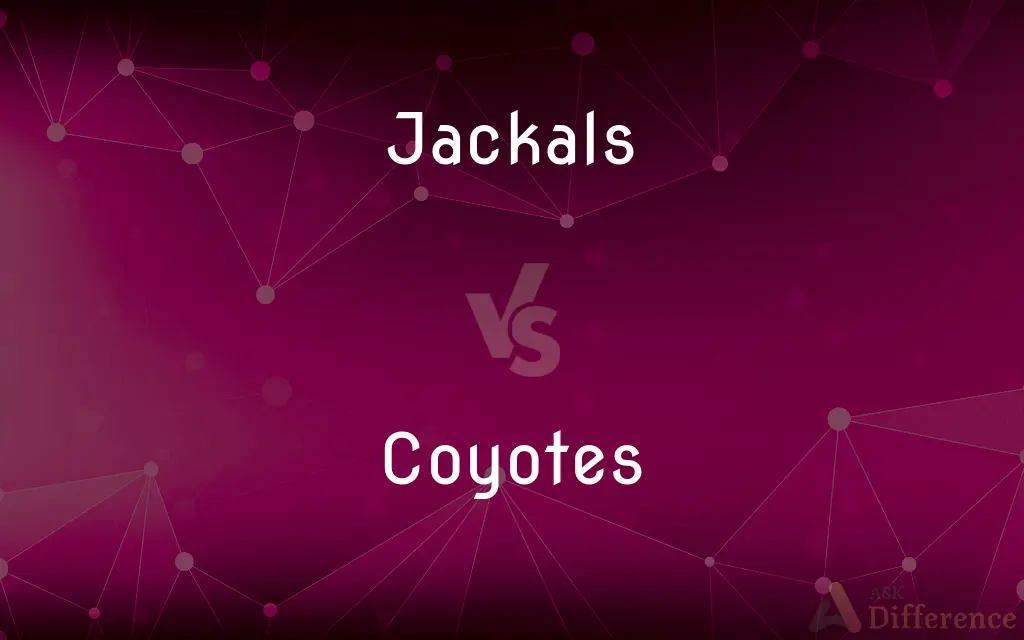Jackals vs. Coyotes — What's the Difference?
Edited by Tayyaba Rehman — By Fiza Rafique — Published on November 15, 2023
Jackals are small to medium-sized canids native to Africa and Asia, while coyotes are larger canids found in North and Central America.

Difference Between Jackals and Coyotes
Table of Contents
ADVERTISEMENT
Key Differences
Jackals and coyotes are both members of the canid family but hail from different parts of the world. Jackals predominantly roam the terrains of Africa and parts of Asia. Their habitats range from deserts to grasslands, showcasing their adaptability. Coyotes, on the other hand, are native to North and Central America. They are often found in plains, forests, mountains, and urban areas, reflecting their own versatile nature.
In terms of size and appearance, jackals are generally smaller than coyotes. While both creatures exhibit a resemblance to domestic dogs, coyotes tend to be taller and have a more pronounced snout. Jackals have shorter legs, a pointed snout, and come in a variety of colors depending on the species.
Behaviorally, both jackals and coyotes are known for their cunning and resourcefulness. Jackals often hunt in pairs or small groups, and their diet comprises both plants and smaller animals. Coyotes, while known to hunt solo or in pairs, can occasionally form larger packs. Their diet is more varied, including fruits, insects, small mammals, and even larger prey when hunting in a group.
Though both jackals and coyotes share certain behavioral traits, their vocalizations differ. Jackals are known for their eerie and haunting calls, often heard during the evening. Coyotes, in contrast, are recognized for their distinctive howls, which can travel long distances and are sometimes joined by other coyotes in a chorus.
Comparison Chart
Native Region
Africa and parts of Asia
North and Central America
ADVERTISEMENT
Size
Generally smaller than coyotes
Larger than most jackals
Habitats
Deserts, grasslands
Plains, forests, mountains, urban areas
Hunting Behavior
Often in pairs or small groups
Solo or in pairs, occasionally in larger packs
Vocalizations
Eerie calls, especially in the evening
Distinctive howls, often answered by others in a chorus
Compare with Definitions
Jackals
Small to medium-sized canids found in Africa and Asia.
The jackals' calls echoed hauntingly in the night.
Coyotes
Large canids native to North and Central America.
Coyotes are often seen roaming the plains of North America.
Jackals
Often hunt in pairs or small groups.
The pair of jackals stealthily stalked their prey.
Coyotes
Often hunt alone or in pairs but can form larger packs.
A pack of coyotes worked together to bring down a larger prey.
Jackals
Carnivorous mammals known for their adaptability.
Jackals often thrive in environments ranging from deserts to grasslands.
Coyotes
Known for their distinctive howls and vocalizations.
The howl of the coyotes echoed throughout the canyon.
Jackals
Recognizable by their pointed snouts and varied coat colors.
The golden coat of the jackals shimmered under the sun.
Coyotes
Possess a taller stature and a pronounced snout compared to jackals.
With their alert stance and keen eyes, coyotes are often seen as the sentinels of the plains.
Jackals
Members of the canid family, resembling domestic dogs.
To the untrained eye, jackals might resemble certain breeds of domestic dogs.
Coyotes
Highly adaptable animals found in various habitats.
Urban areas have seen an increase in coyotes due to their adaptability.
Jackals
Any of several mammals of the genus Canis of Africa, Asia, and southeast Europe, that are chiefly foragers feeding on plants, small animals, and occasionally carrion.
Coyotes
A wolflike carnivorous mammal (Canis latrans) of North and Central America, having grayish-brown or yellowish fur, large erect ears, and a drooping bushy tail. Also called prairie wolf.
Jackals
One who seeks to gain advantage or profit from the difficulties of another.
Coyotes
A firefighter who is sent to battle remote, usually very severe forest fires, often for days at a time.
Jackals
One who performs menial tasks for another.
Coyotes
(Slang) A person who smuggles undocumented immigrants into the United States, especially across the Mexican border.
Jackals
Plural of jackal
Coyotes
Plural of coyote
Common Curiosities
Are jackals and coyotes related?
Yes, both are members of the canid family but are different species.
How do coyotes communicate?
Coyotes are known for their distinctive howls, often used to communicate over long distances.
Can jackals be domesticated?
While they share similarities with dogs, jackals are wild animals and aren't typically domesticated.
What do jackals eat?
Jackals have a varied diet, including plants, insects, and small mammals.
Where can I find jackals in the wild?
Jackals are primarily found in Africa and parts of Asia.
Are coyotes dangerous to humans?
Coyotes usually avoid humans but can be dangerous if threatened or if habituated to human presence.
Do coyotes live in urban areas?
Yes, coyotes have been known to adapt to urban environments.
Are coyotes larger than jackals?
Generally, yes. Coyotes are larger than most jackal species.
How do jackals and coyotes differ in vocalizations?
Jackals have eerie calls, especially at dusk, while coyotes are known for their howling.
Are there myths or legends associated with jackals and coyotes?
Both animals feature in various cultural stories; for example, the coyote is a trickster figure in Native American lore.
Can jackals and coyotes interbreed?
While they are both canids, they are distinct species and do not typically interbreed.
How many species of jackals are there?
There are several species, including the golden jackal, black-backed jackal, and side-striped jackal.
Are jackals active during the day or night?
Jackals can be active during both day and night but are especially vocal in the evenings.
What's the lifespan of a coyote?
In the wild, coyotes typically live 6-8 years but can live longer in captivity.
Do jackals and coyotes have similar diets?
Both are opportunistic eaters, but coyotes have a more varied diet, sometimes including larger prey.
Share Your Discovery

Previous Comparison
WAV vs. MP4
Next Comparison
Sunflower Oil vs. Safflower OilAuthor Spotlight
Written by
Fiza RafiqueFiza Rafique is a skilled content writer at AskDifference.com, where she meticulously refines and enhances written pieces. Drawing from her vast editorial expertise, Fiza ensures clarity, accuracy, and precision in every article. Passionate about language, she continually seeks to elevate the quality of content for readers worldwide.
Edited by
Tayyaba RehmanTayyaba Rehman is a distinguished writer, currently serving as a primary contributor to askdifference.com. As a researcher in semantics and etymology, Tayyaba's passion for the complexity of languages and their distinctions has found a perfect home on the platform. Tayyaba delves into the intricacies of language, distinguishing between commonly confused words and phrases, thereby providing clarity for readers worldwide.











































